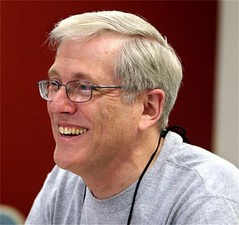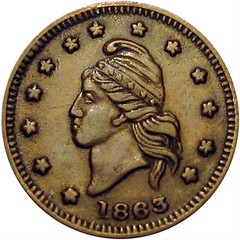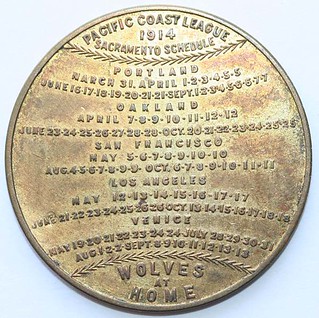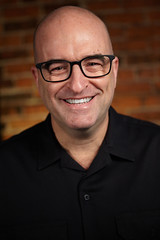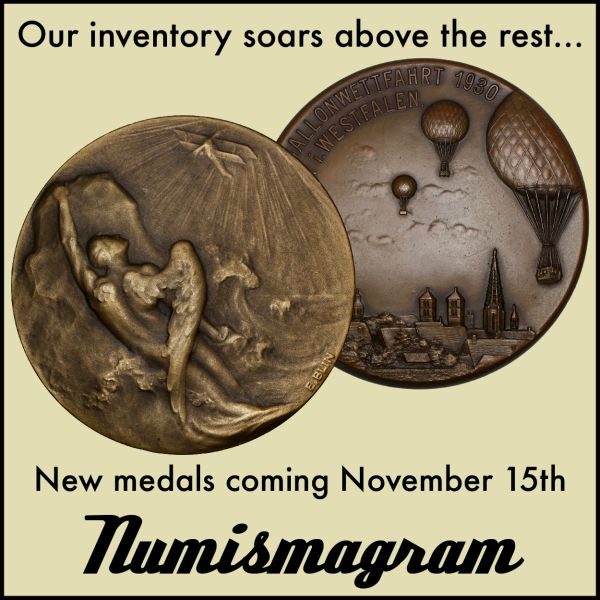
PREV ARTICLE
NEXT ARTICLE
FULL ISSUE
PREV FULL ISSUE
DAVID SCHENKMAN INTERVIEW, PART TWOGreg Bennick's latest interview for the Newman Numismatic Portal is with token expert David Schenkman. Here's the second of six parts, where Dave discusses discovering Civil War Tokens. -Editor
I was fascinated by them because there was so much more diversity than there was with the cents which were the same except for the dates. He gave them to me, and I started collecting Civil War tokens. And I was a member of a couple of local coin clubs. And I would pester everybody for tokens and people would bring in tokens because very few people were interested in them, at least where I lived. And I got to the point where I had probably about two hundred Civil War tokens, and what I started seeing were duplicates of everything that I had. When I'd see something else, like I wasn't picking up anything new, so I sort of assumed that I probably had them all. And then somebody gave me a copy of George Fuld's book on Civil War tokens, actually two little black books. And my bubble burst because he listed about 7000 varieties. So, I realized I didn't know a whole lot about these, but I had a book! So now I could at least find out which ones were rare and which ones were common. And so that really spurred my interest. And from there I branched out to other types of tokens and obsolete paper money and to a certain extent, coins also. And eventually I went in the coin business full time. I did that for a number of years. I'm no longer doing that, but I still have as much interest in coins as I always did. Greg Bennick: Well, let's take one step back. Let's say for a beginning listener, what is, since you mentioned them first, a Civil War token?
Greg Bennick: So, it sounds in a way much like Conder tokens and the role that they served in in the UK, where there just was a shortage of coinage and these coins were made to supplement a lack of coinage, to provide for commerce to continue to exist. I guess that was the same thing with Civil War tokens then.
David Schenkman: Well, it was. And like Conder tokens, a lot of them were made for
collectors. There were collectors of these tokens during the war and shortly after the war. The
collectors that lived in the areas where there were die sinkers that were making Civil War
tokens would go to the die sinker to look at his dies and say well, make the five of these with
this die and this die, make me five in silver and fifteen in German silver or whatever. And they
were creating - instant rarities - that now sell for large amounts of money. And what they would
do is they would put one in their collection and then they would trade with collectors in other
areas that were doing the same thing with die sinkers in their areas. And so, a good deal of the
Civil War tokens are really not Greg Bennick: So, they were struck almost as numismatic delicacies the way that in the 1870s or so, there was a number of numismatic delicacies in terms of patterns made at the Mint for collectors at their request and whatnot. These were things that were made both by the die sinkers themselves, but maybe at the request of collectors also in order to create delicacies or rarities. David Schenkman: Well, everybody likes a rarity. They were doing the same thing with Conder tokens in the 1790's because there were coin… in fact some of the Conder tokens advertised coin dealers. Greg Bennick: So basically, the coin dealers who were using the opportunity that Conder tokens, for example, were making rarities and striking those rarities as advertisements for the fact that they were selling those rarities! It's pretty convenient. David Schenkman: Yeah. Greg Bennick: So taking a step even further back. Of course, tokens and Civil War tokens and Conder tokens all fall under the token banner. Tell us about tokens. There are so many. And I know that my father was a token collector and you've specialized in tokens. You've made mention of the merchant connection to tokens. Tell us what a token is. And I don't mean that as such a rudimentary question as to say a disk of metal, but when people think of tokens, they think maybe of just transportation tokens first and foremost. But tell us about what a token is and the purpose that they served in terms of commerce over the last few hundred years. David Schenkman: Tokens serve a lot of purposes over the years. As you mentioned, transportation merchants issued tokens extensively from the 19th century and the 20th century up until even modern times, although to a lesser extent. And these tokens were generally, one side would say the name of the merchant might say Joe Blow's Saloon, Bluefield, West Virginia, and the other side would say good for $0.05 in trade or good for a drink or something of the sort. And they were circulated in various ways, and they weren't really intended to circulate the way Civil War tokens circulated. In some cases, the bartender would charge $0.25 for two drinks. So, when you paid a quarter for two drinks, he would give you one drink and a token that was good for a drink. This way he ensured future business. So that was another use for them. Some tokens were just strictly advertising. These are generally larger. We could spend the next hour talking about the uses of tokens because there's lots of uses.
Greg Bennick: So basically, mechanisms of not just advertising but of keeping business going. It seems quite obvious to say, but your allusion to the fact that there's a countless number of ways that tokens were used is fascinating because it makes me think, how does one collect them? Meaning it's very easy if putting together a date set, which is sort of a modern approach to coin collecting and collecting by date certainly wasn't always a thing. And I guess my question is, how does one then collect tokens? It's very easy to collect if you're looking for a date set of Indian cents, but what do you do in terms of tokens? How do people approach collecting these things? David Schenkman: Well, that's not an easy question to answer, but in general terms, I think most importantly, well, two things. One, buy books. It's not as simple as collecting coins where a Red Book might get you by. You need books, and there's a lot of them. And they tend to be pricey because they're usually published in small quantities. But if you know what you're doing, they can make you a lot of money if you're buying for investment or for resale. And the other thing is to join numismatic organizations, for instance with tokens, the Token and Medal Society, which is a national nonprofit organization that's been in existence since 1961. I believe you're a recent member. Greg Bennick: Yeah, I am. David Schenkman: And they publish a magazine six times a year and occasionally supplement issues on specific topics, and they also publish books from time to time. There are other organizations that are more specialized. For instance, there's a transportation token society that publishes a monthly newsletter, and they've been doing that since, I believe, 1948. And of course, the American Numismatic Association, I would be remiss if I didn't put in a plug for them because that's our national magazine. And they have articles on tokens and medals and paper money and whatever else you might imagine. Greg Bennick: While we're on the subject, I'll say that the Token and Medal Society puts out a magazine, as you said, the TAMS Journal, and this has a full color cover, it's on glossy paper, it's pretty nice and full color all throughout. It's a really impressive magazine. I actually just got my first issue the other day flipping through, seeing your article, and then there's just a wide variety of articles. And what's interesting is that I don't have an extensive background with tokens, and still I joined just to learn something brand new about an area of numismatics that I know very little about. And there's a lot of that to learn in this magazine. So I'd highly recommend that without a doubt. And I agree with you also about books. One thing I want to ask you about for sure is a really specific topic. I just bought a copy recently of your book, Virginia Tokens, that's about as specific as you're going to get. I mean, this book, I'm looking at here it's about an inch and a half thick. It's got about 600 pages, and you could probably tell us more about it. But this is a really specific work, and I can't imagine a greater reference on Virginia tokens. It's enough, just this book alone to get one started, a collection of these things. What could you tell us about that book specifically? David Schenkman: Well, in the first place, it's absolutely the best reference on Virginia tokens ever written, primarily because it's the only reference! So getting back to the tokens with this is a good example as any. I wrote the first version of this book in 1980, and it was about 200 pages in it, and it listed 2500 tokens. That was every token that I knew about from the State of Virginia. And I had corresponded extensively with other collectors and looked at collections and went up to the ANS in New York. But this book that you just got, which was published by the Virginia Numismatic Association four or five years ago, I guess, lists 6000 tokens - well over twice as many. So that's as many tokens that have come out, not come out, that's a bad choice of words, but have been discovered since the first edition.
One thing that people should remember about tokens is the fact that it's not as easy to
understand as it is coins. For instance, if you collect Lincoln cents you know exactly where you
stand in the hobby, you need seven dates to complete, you need this, you need that. With
tokens, there's really no way of knowing when you're complete because you probably never are.
So that can be a frustration or it can be a satisfying thing because you can also find things that
nobody else has ever found. The problem is if you want to collect is you can't just go out and
buy everything you want to buy. And a good example as any, I collect seriously a Virginia
transportation tokens. I've got almost every one known to exist except for one company that
operated out of Suffolk,Virginia and it was a bus company that operated during the thirties, I
believe. They issued four tokens. They're very distinctive types of tokens. I bought two of them
in probably the 1980s, sometime around there. And since then, I've looked for the other two.
Last year, one of them came up at an auction, I was able to buy it for $400, roughly. I would
have paid more. I would love to buy the last one, and I would pay more than $400 for it, but you
can't just go out and buy it. In tokens, we tend to call something not rare if there are maybe 20
of them around, we don't term it Greg Bennick: Is this because less were made. Or is this because less of them survived after many many were made, that there's so few around today? David Schenkman: I acquired years ago the mintage of photocopy of an original die sinker who manufactured coal mine scrip tokens from the twenties through the fifties. And some of the mintages are as high as a thousand, a lot of them are under a hundred. I've owned plenty of tokens with a total mintage with only fifty, so obviously if only fifty were made, there's not going to be a lot of them around.
Greg Bennick: Now, it's interesting that you brought up the fact that tokens are an area of
numismatics that you might pursue and never finish. When I interviewed Bill Groom recently
and Bill's specialty is counterstamps, Bill referred to counterstamps as
David Schenkman: I think that there are a lot of frontiers in numismatics, and I've never been
able to understand the obsession that some collectors have, and I hope I'm not going to alienate
too many people when I say this, with getting a coin that a grading service is graded at one
point higher than the one below it and paying three times as much for that one point when you
generally can't even see it unless you really know what you're looking for. So as far as frontiers
go, Bill is correct, there are a lot of counterstamps that will never be identified. There are also
lots of tokens that will never be identified. The are what we refer to as mavericks and a
maverick is a token that does not contain enough information in its inscription to enable
identification. And interestingly enough, the term maverick comes from a rancher in Texas in
the 19th century who refused to brand his cattle, and his name was Sam Maverick. And
unbranded cattle came to be referred to as Greg Bennick: I've never heard that before. That's totally fascinating. David Schenkman: If you look at the one section of the TAMS Journal, every issue there is a maverick section, usually four or five pages towards the back and those are all mavericks. There's a section of ones that people have identified, and there is a section of ones that have not been identified that people have sent in descriptions of. Greg Bennick: Wow, I'm literally looking at it right now. So, these are things that people are finding, figuring out, and connecting to historical sources and references. It's literally the frontier that we're talking about. Meaning that it's people doing the research about this field of numismatics as we speak. You know, basically in time for the next issue of the TAMS Journal to come out. It's pretty fascinating that people can be that participatory because you're right, it's quite true that I don't know if people are going to discover anything new about the Morgan dollar series with the same speed perhaps, or the same amount of discoveries as seems to be happening in tokens and counterstamps. David Schenkman: Yeah. And they've been running that column pretty much since the first days of the magazine, which was 1961. A lot of tokens have been published in that magazine over the years. I edited that magazine for 27 years, and I can tell you that there's an amazing diversity of articles.
To watch the complete video, see:
To read the complete transcript, see:
To read the earlier E-Sylum article, see:
Wayne Homren, Editor The Numismatic Bibliomania Society is a non-profit organization promoting numismatic literature. See our web site at coinbooks.org. To submit items for publication in The E-Sylum, write to the Editor at this address: whomren@gmail.com To subscribe go to: https://my.binhost.com/lists/listinfo/esylum All Rights Reserved. NBS Home Page Contact the NBS webmaster 
|
